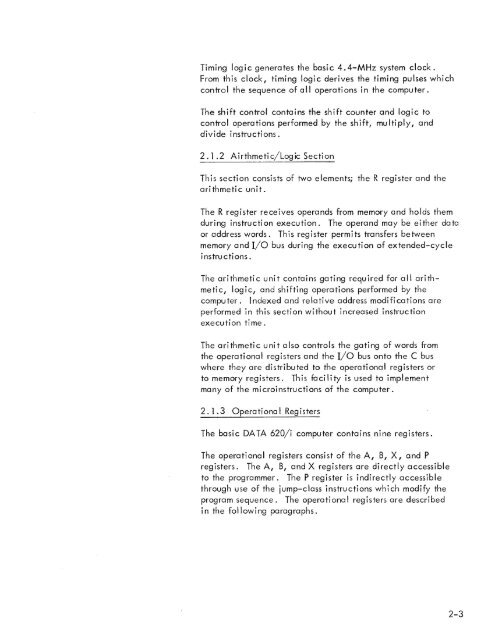DATA 620/i SYSTEM REFERENCE MANUAL . - Al Kossow's Bitsavers
DATA 620/i SYSTEM REFERENCE MANUAL . - Al Kossow's Bitsavers
DATA 620/i SYSTEM REFERENCE MANUAL . - Al Kossow's Bitsavers
You also want an ePaper? Increase the reach of your titles
YUMPU automatically turns print PDFs into web optimized ePapers that Google loves.
Timing logic generates the basic 4.4-MHz system clock.<br />
From this clock, timing logic derives the timing pulses which<br />
control the sequence of all operations in the computer.<br />
The shift control contains the shift counter and logic to<br />
control operations performed by the shift, multiply, and<br />
divide instructions.<br />
2.1.2 Airthmetic/Logic Section<br />
This section consists of two elements; the R register and the<br />
ari thmeti c un it.<br />
The R register receives operands from memory and holds them<br />
during instruction execution. The operand may be either data<br />
or address words. Th i s reg i ster permits transfers be tween<br />
memory and I/O bus during the execution of extended-cycle<br />
instructions.<br />
The arithmetic unit contains gating required for all arithmetic,<br />
logic, and shifting operations performed by the<br />
computer. Indexed and relative address modifications are<br />
performed in this section without increased instruction<br />
execution time.<br />
The arithmetic unit also controls the gating of words from<br />
the operational registers and the I/O bus onto the C bus<br />
where they are distributed to the operational registers or<br />
to memory registers. This facility is used to implement<br />
many of the microinstructions of the computer.<br />
2.1.3 Operational Registers<br />
The basic <strong>DATA</strong> <strong>620</strong>/i computer contains nine registers.<br />
The operational registers consist of the A, B, X, and P<br />
registers. The A, B, and X registers are directly accessible<br />
to the programmer. The P register is indirectly accessible<br />
through use of the jump-class instructions which modify the<br />
program seque nce. The operati ona I reg is ters are descri bed<br />
in the following paragraphs.<br />
2-3

















